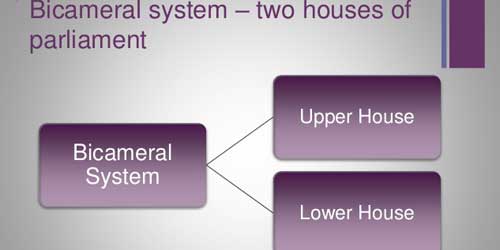A bicameral parliamentary system is a system of two legislative Chambers. Indian system is bicameral because both the Lok Sabha and the Rajya Sabha are involved in the process of making new laws. Bicameral literally means ‘two chambers’.
Countries with Bicameral Parliamentary System:
- Australia-Parliament–Senate–House of Representatives
- Austria-Parliament–Federal Council–National Council
- Antigua and Barbuda-Parliament–Senate–House of Representatives
- The Bahamas-Parliament–Senate–House of Assembly
- Barbados-Parliament–Senate–House of Assembly
- Belize–National Assembly–Senate–House of Representatives
- Belgium-Federal Parliament–Senate–Chamber of Representatives
- Bhutan-Parliament (Chitshog)–Bhutan will become a Democratic Constitutional Monarchy in 2008–National Council (Gyalyong Tshogde)– National Assembly (Gyalyong Tshogdu)
- Canada-Parliament–Senate–House of Commons
- Czech Republic-Parliament–Senate–Chamber of Deputies
- Ethiopia-Federal Parliamentary Assembly–House of Federation– House of People’s Representatives
- Germany–Bundesrat (Federal Council)–Bundestag (Federal Diet)
- Grenada-Parliament–Senate–House of Representatives
- India-Parliament–Rajya Sabha (Council of States)–Lok Sabha (House of People)
- Ireland-Oireachtas–Seanad Éireann–Dáil Éireann
- Iraq-National Assembly–Council of Union [2]–Council of Representatives
- Italy-Parliament–Senate of the Republic–Chamber of Deputies
- Jamaica-Parliament–Senate–House of Representatives
- Japan-Diet–House of Councillors–House of Representatives
- Malaysia-Parliament–Dewan Negara–Dewan Rakyat
- The Netherlands-States-General–Eerste Kamer–Tweede Kamer
- Pakistan-Majlis-e-Shoora–Senate–National Assembly
- Poland-Parliament–Senate–Sejm
- Romania-Parliament–Senate–Chamber of Deputies
- Saint Lucia-Parliament–Senate–House of Assembly
- Slovenia-Parliament–National Council–National Assembly
- South Africa-Parliament–National Council of Provinces–National Assembly
- Spain-Cortes Generales–Senate–Congress of Deputies
- Switzerland-Federal Assembly–Council of States–National Council
- Thailand-National Assembly [3]–Senate–House of Representatives
- Trinidad and Tobago-Parliament–Senate–House of Representatives
- United Kingdom-Parliament–House of Lords–House of Common
Also, Read:
Constitutional Development in India From Regulating Act 1773 to Govt. of India Act 1935

Lots Of Countries Follows The Bicameral System.I Think This System is Nice.
I sending my views about our Parliament that Bicameral systemis not fit for our democracy. Suppose to be Lok-shabha passed a essential bills in house with majority,but another house dropped it in dustbin. How can we established the needs of our country when our specific mandate makes a majority government.
We should be changed our system of the Parliament. The boths house have to governance a board of administrator,thouse who are empowered by the Constitution & also his Excellency the President of India.That administration decided the crucial matter within the stipulated period,only then we becomes a strong parliament.
Decentrelized system is the more apropriate in which state goverenment should be cancled and direct district authority has power for making local laws so that can satisfy each localized need. and one suprime comand with centrel level and it should has malitary power for protact and defance our national geography and frome foreighn attacs. this can be possible only when party system is cancaled first
Comments are closed.